Mediterranean vinegar pickling starts with a 1:1 ratio of vinegar (5% acidity) to water, combined with kosher or sea salt at 2-3 tablespoons per quart of liquid. You'll need firm, fresh vegetables cut into uniform pieces, and traditional herbs like thyme, oregano, and dill. Pack your cleaned vegetables tightly in sterilized glass jars, then pour the cooled brine over them until they're fully submerged. For authentic Mediterranean flavor, add whole spices like coriander seeds, black peppercorns, and bay leaves. Don't forget to include garlic cloves and a thin layer of olive oil on top. The secrets to perfect Mediterranean pickles lie in the details that follow.
Essential Mediterranean Pickling Ingredients
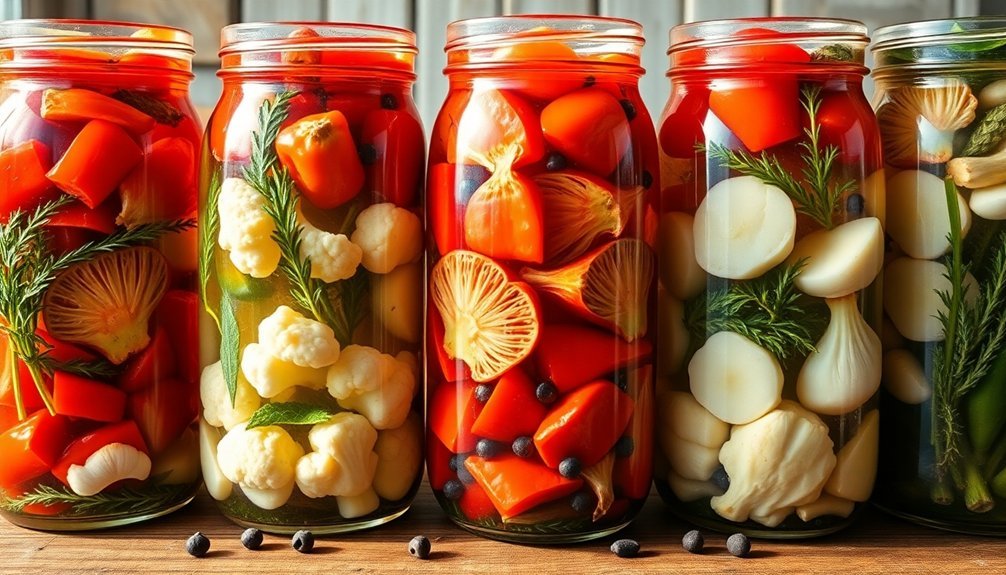
The foundation of Mediterranean pickled vegetables lies in the careful selection of pickling ingredients.
You'll want to start with white wine vinegar or red wine vinegar, as these varieties add a pleasing Mediterranean character to your pickles. You can combine these with distilled white vinegar to achieve the perfect balance of acidity and flavor. The vinegar-to-water ratio should be equal parts to create an ideal pickling solution.
For the brine, you'll need pure sea salt or kosher salt – both excellent Mediterranean options that won't cloud your pickling liquid or add unwanted minerals. Use about one tablespoon of salt per cup of your vinegar-water mixture.
While sugar isn't traditional in many Mediterranean pickles, you can add a small amount to balance the acidity if needed.
The signature Mediterranean flavor comes from specific spices and herbs. Include whole coriander seeds, black peppercorns, and fresh herbs like thyme, oregano, and bay leaves.
Fresh garlic is essential – add several peeled cloves to each jar. For an authentic touch, you might also want to include some fresh rosemary sprigs and a pinch of red chili flakes.
These aromatics will infuse your vegetables with classic Mediterranean flavors during the pickling process.
Selecting Quality Fresh Produce
Selecting pristine vegetables forms the cornerstone of successful Mediterranean pickling. You'll want to choose vegetables that are firm, crisp, and free from any bruising or soft spots. Look for vibrant colors and crunchy textures in your produce, making sure each piece is fresh and at its peak ripeness. Early summer harvest offers the best selection of garden-fresh vegetables for pickling.
Before you begin the pickling process, it's crucial to properly prepare your vegetables. Wash them thoroughly and cut them into uniform pieces to guarantee even pickling throughout. Don't forget to remove seeds and cores that could affect the final texture and flavor. If needed, briefly blanch the vegetables in salty water and pat them dry to control moisture levels.
When checking for freshness, trust your senses. Fresh vegetables should have an earthy aroma and be free from any signs of mold or rot. You'll want to avoid using wilted or soggy produce, as they'll compromise your pickling liquid.
Store your prepared vegetables properly until you're ready to pickle them. Keep them in airtight containers in a cool, dry place away from direct sunlight. If you won't be pickling immediately, refrigerate them to maintain their freshness.
Remember to keep all your utensils and work surfaces clean throughout the process.
Jar Preparation and Sterilization
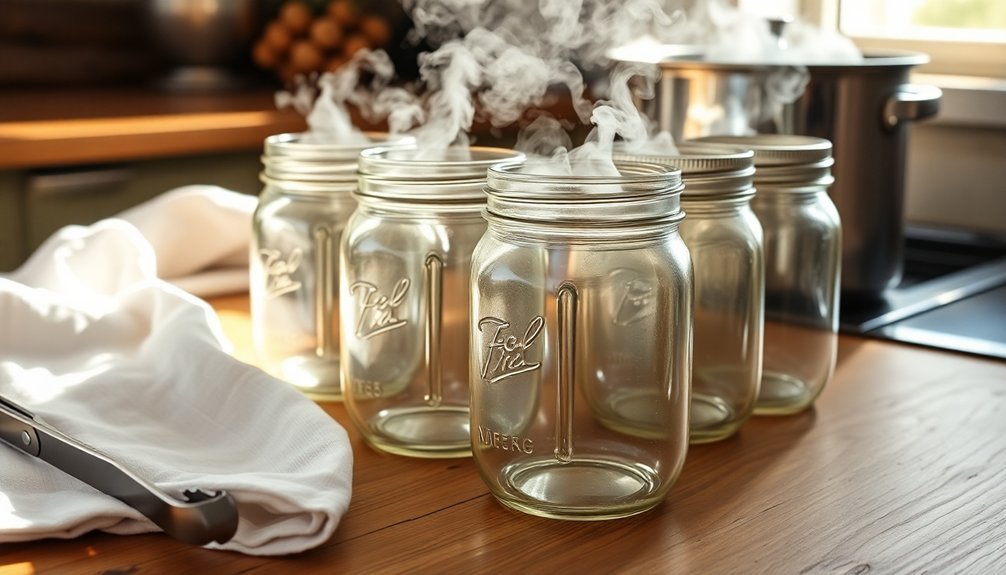
Proper jar preparation and sterilization serve as your foundation for successful Mediterranean pickling. You'll want to select wide-mouth glass jars that make filling and accessing your vegetables easy while preventing any unwanted flavor contamination. Make certain your chosen jars are suitable for refrigeration and can be sealed tightly to maintain freshness.
Before you begin the pickling process, you'll need to properly sanitize your jars. While traditional canning methods often require boiling for sterilization, quick pickling doesn't need such intensive treatment. Instead, you can clean your jars thoroughly with hot water or run them through your dishwasher. This no boiling required method makes the process much simpler for home pickling.
Once cleaned, rinse the jars well with hot water to remove any residue, and dry them completely to prevent water spots that could affect your pickling results.
When you're ready to fill your jars, pack your Mediterranean vegetables tightly to minimize space, but remember to leave enough room for the pickling liquid. You'll need to ascertain your vegetables are completely submerged in the brine to achieve proper pickling.
After filling, seal the jars tightly and check the seals periodically to maintain their effectiveness.
Mediterranean Herbs and Spices
You'll find several signature Mediterranean spice blends that define the region's pickling traditions, from the tangy-smoky sumac of North Africa to the warm coriander seeds favored in Middle Eastern recipes.
Essential herbs like parsley, mint, and dill form the backbone of Mediterranean pickling, with each herb contributing its unique character to the final product.
These herbs and spices can be mixed and matched to create your own authentic Mediterranean pickles, whether you're following Greek, Italian, or Middle Eastern traditions.
Signature Mediterranean Spice Blends
Mediterranean spice blends consistently form the backbone of the region's vibrant cuisine, offering a rich tapestry of flavors from Greece to Morocco. You'll find distinctive combinations like za'atar, which combines sumac's citrusy notes with herbs, perfect for enhancing your pickled vegetables.
The Greek Gods Blend adds depth to your preserving liquid, while the Herbal Garden Blend brings fresh, aromatic notes to your pickling projects.
Regional variations reflect the diverse culinary traditions across the Mediterranean. Turkish blends incorporate Aleppo pepper for heat, while Moroccan combinations feature warming cinnamon and cumin.
For your pickling endeavors, you'll want to focus on spice blends that complement the vinegar's acidity and enhance the vegetables' natural flavors.
- Experience the warmth of sun-dried herbs in every jar you create
- Transform ordinary vegetables into exotic Mediterranean delicacies
- Connect with centuries-old preservation traditions through authentic spice combinations
When crafting your pickling spice blend, start with core ingredients like dried oregano and garlic powder as your base.
Add paprika for color and depth, then customize with regional-specific elements like sumac or Aleppo pepper to achieve your desired flavor profile.
Essential Herbs From Region
Fresh herbs form the heart and soul of Mediterranean pickling, building upon the robust foundation of regional spice blends. You'll want to incorporate oregano, basil, and thyme as your primary aromatics, as they're not only traditional to the region but also contribute to the preservation process through their antimicrobial properties.
When you're preparing your pickling brine, don't overlook the power of garlic, which serves dual purposes: it adds distinctive flavor while providing natural antibacterial benefits that help preserve your vegetables. You can enhance your pickles' complexity by adding parsley, which brings a fresh, green note and additional health benefits through its flavonoids.
For the most authentic Mediterranean pickle flavors, you'll need to balance these herbs carefully. Consider combining chopped basil and oregano throughout your jarred vegetables, while adding crushed garlic cloves directly to the brine.
You can also experiment with tarragon and coriander, which bring their own preservation benefits and distinct flavors. Remember to include bay leaves in your brine – though optional, they're traditional in Mediterranean pickling and contribute to the overall depth of flavor.
Making the Vinegar Brine
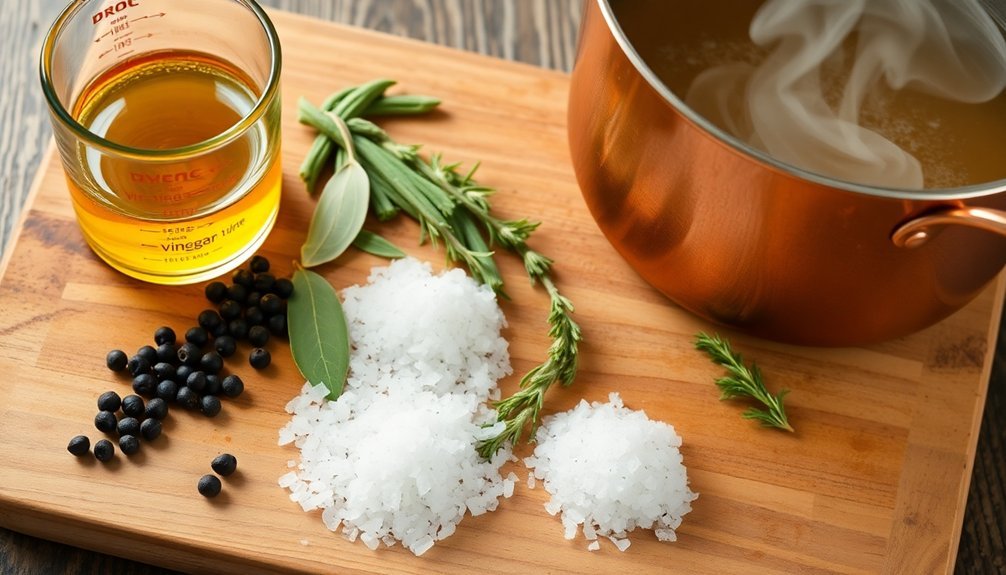
To make a Mediterranean-style vinegar brine, you'll need to balance a 1:1 ratio of water to vinegar with 2-3 tablespoons of salt per quart of liquid.
You'll want to enhance your brine with traditional Mediterranean herbs like oregano, thyme, and bay leaves, along with garlic and black peppercorns.
Before you begin, gather your essential equipment including clean mason jars, a non-reactive saucepan, measuring cups, and a funnel for easy pouring.
Perfecting Salt-Acid Ratios
Creating a perfectly balanced brine lies at the heart of successful Mediterranean pickled vegetables. You'll need to maintain a strict 1:1 ratio of vinegar to water, ensuring your vinegar contains 5% acidity. For ideal results, use kosher or sea salt rather than table salt, as these varieties dissolve cleanly without unwanted additives that could affect your pickles' appearance and taste.
When measuring your ingredients, opt for weight rather than volume measurements to achieve consistent results. You'll want to bring your brine to a gentle simmer, just enough to dissolve the salt and any sugar you've added for flavor balance.
Remember that at least 50% of your liquid must be vinegar to maintain a safe pH level below 3.5.
- Watch your vegetables transform from ordinary to extraordinary as they absorb the perfectly balanced brine
- Experience the satisfaction of creating preserved foods using time-tested Mediterranean methods
- Share your homemade pickled vegetables with friends and family, knowing you've crafted them safely
Test your brine's flavor before adding it to your vegetables, and don't hesitate to adjust the salt-acid balance to suit your taste while maintaining safety ratios.
Store your finished pickles in non-reactive containers, preferably glass mason jars, for best results.
Traditional Mediterranean Herbs
Rich Mediterranean herbs transform a basic vinegar brine into an aromatic masterpiece. You'll want to focus on classic Mediterranean herbs like oregano, basil, dill, parsley, and thyme to create an authentic flavor profile. Whether you're using fresh or dried herbs, proper measurements are essential – use 1-2 teaspoons of fresh minced herbs or 1 teaspoon of dried herbs per recipe.
| Herb | Fresh Amount | Best Paired With |
|---|---|---|
| Oregano | 2 tsp minced | Peppers, tomatoes |
| Basil | 2 tsp chopped | Zucchini, eggplant |
| Dill | 1 tsp minced | Cucumbers, carrots |
| Thyme | 1 tsp stripped | Root vegetables |
You can distribute the herbs throughout the jar or layer them at the bottom before adding your vegetables. The herbs will help balance the brine's acidity while enhancing the natural flavors of your pickled vegetables. Store your herbed pickles in the refrigerator, where they'll keep for several months. Don't discard the leftover brine – it's perfect for marinating meats or as a flavorful dressing base. Remember to taste and adjust your herb seasoning before adding the vegetables to guarantee the perfect Mediterranean flavor.
Essential Equipment Needed
Proper equipment selection makes all the difference when preparing Mediterranean pickled vegetables. You'll need precise measuring tools to create the perfect brine, starting with a large measuring cup or bowl for mixing, and a reliable kitchen scale for accurate ingredient portions.
A whisk or sturdy spoon helps dissolve the salt and sugar thoroughly, while a pot comes in handy if you need to heat the brine.
For storage, clean glass jars with tight-fitting lids are essential. Mason jars work exceptionally well, but you can also use Weck jars or quart-sized deli containers.
To guarantee your brine's strength is perfect, you'll want a hydrometer or refractometer for precise measurements. A pH meter isn't required but can help maintain consistent acidity levels across batches.
- Nothing beats the satisfaction of hearing that perfect 'pop' when your jar seals properly
- You'll feel like a skilled artisan using traditional tools like the egg test to check brine strength
- There's something deeply rewarding about seeing your neatly packed jars lined up on the shelf
Don't forget your cutting tools – a sharp knife or mandolin will help you achieve consistent vegetable sizes for even pickling.
Preparing Your Vegetables
Successfully preparing Mediterranean pickled vegetables starts with carefully selecting and treating your produce.
You'll want to choose fresh, uniform vegetables free from damage or decay, avoiding waxed supermarket options. Select a variety of vegetables like cauliflower, carrots, and cucumbers to create diverse flavors and textures in your Mediterranean pickle mix.
Begin by thoroughly scrubbing your vegetables to remove dirt and debris. For cucumbers, don't forget to cut off a ¼-inch slice from the blossom end to prevent softening.
Peel, slice, or chop your vegetables uniformly according to your recipe, removing any unwanted leaves or stems.
To guarantee your pickles stay crisp, you'll want to treat them with pickling salt. Spread a layer of salt over your prepared vegetables and let them sit overnight in a cool place.
The salt will draw out excess moisture, resulting in crunchier pickles. After the salt treatment, rinse the vegetables and dry them completely.
When you're ready to pickle, add your vegetables to the pickling solution, making sure they're fully submerged.
Use a slotted spoon to transfer them to your pickling container, then pour the cooled solution over them.
Packing and Sealing Methods
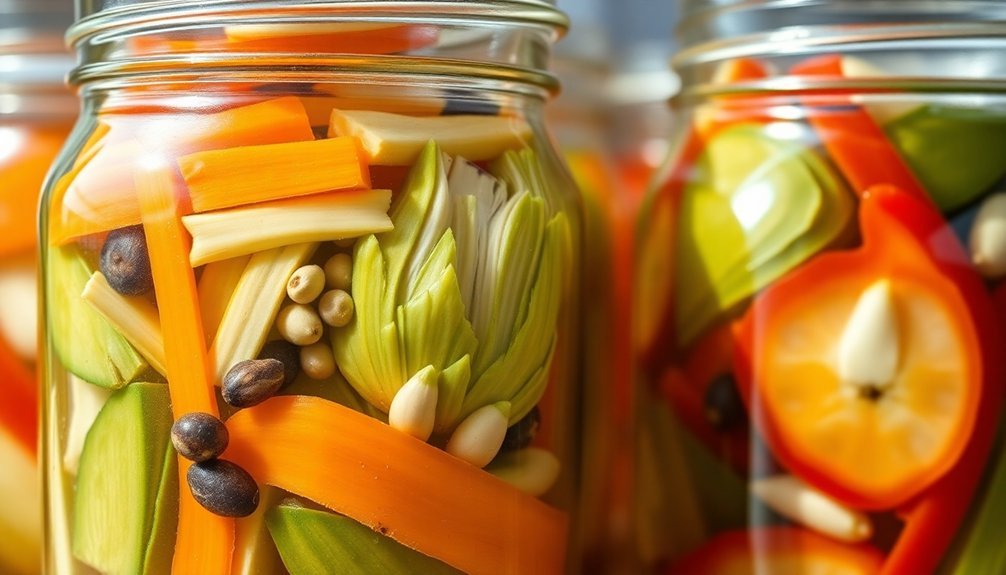
Begin packing your Mediterranean vegetables in sanitized mason jars by creating visually appealing layers of colorful produce, making sure to leave about an inch of headspace at the top.
You'll want to press the vegetables down firmly to eliminate air pockets while maintaining their shape and arrangement, ensuring they're completely covered by the pickling brine.
Secure the jar with a two-piece lid, tightening the band until it's snug but not overly tight, which allows for proper sealing while preventing contamination.
Jar Layering Techniques
When layering Mediterranean pickled vegetables, mastering the right packing technique guarantees even distribution of flavors and ideal preservation. Start by placing your aromatic elements like garlic cloves, fresh dill sprigs, and whole spices at the bottom of your sterilized jars. These foundational ingredients will infuse the entire batch with their distinctive Mediterranean flavors.
Next, you'll want to pack your prepared vegetables in tight, attractive layers. Use a combination of colorful ingredients like sliced beets, cucumber spears, and carrot sticks, ensuring each piece is similar in size for even pickling. As you layer, press down firmly with a muddler or wooden spoon to eliminate air pockets and create a dense pack.
- Imagine the satisfaction of opening your jar weeks later to find perfectly preserved, vibrantly colored vegetables.
- Picture the pride you'll feel serving these handcrafted pickles at your next gathering.
- Envision the wonderful aromas that'll fill your kitchen as you create this Mediterranean tradition.
Leave about ¾-inch headspace at the top of each jar before adding your hot brine. Tap the jars gently against your counter to release any trapped air bubbles, ensuring every vegetable is completely submerged in the pickling liquid.
Airtight Closure Steps
The art of achieving an airtight seal builds directly upon proper jar layering and marks the final step in preserving your Mediterranean vegetables. To guarantee your pickles remain fresh and flavorful, you'll need to follow precise sealing techniques that prevent contamination while maintaining the perfect preservation environment.
Start by gently tapping your filled jars to release any trapped air bubbles. Once you've added the cooled brine, leave approximately half a finger's width of headspace at the top. If you're using lidded jars, add a thin layer of olive oil before sealing. For vacuum-sealed bags, use a chamber vacuum sealer to remove all air completely.
| Step | Action | Purpose |
|---|---|---|
| 1 | Sterilize containers | Prevent bacterial growth |
| 2 | Tap jars gently | Release trapped air |
| 3 | Add olive oil (jars only) | Create protective barrier |
| 4 | Seal container/bag | Maintain vacuum |
| 5 | Store properly | Guarantee preservation |
After sealing, let your containers cool to room temperature before refrigerating. You'll want to store them in a cool, dark place and allow the pickles to rest for several hours or overnight to develop their full flavor profile.
Traditional Mediterranean Pickling Combinations
Ancient Mediterranean pickling traditions feature distinctive combinations of vegetables, spices, and brining methods that have endured for generations.
You'll find robust combinations of cabbage chunks, cauliflower florets, and thinly sliced carrots paired with aromatic garlic and vibrant spices. The signature blend often includes turnips and peppers, creating a colorful medley that's both visually appealing and flavorful.
The pickling solution typically combines white or apple cider vinegar with kosher salt, water, and optional sugar to achieve the perfect balance of acidity.
You'll want to enhance your pickles with traditional Mediterranean seasonings like turmeric, mustard seeds, and celery seeds. Adding lemon slices, bay leaves, and regional herbs such as dill, thyme, and oregano will create authentic Mediterranean flavors.
- Feel the connection to centuries-old traditions as you recreate these time-tested combinations
- Experience the satisfaction of preserving seasonal vegetables using ancient methods
- Discover the joy of sharing these colorful, aromatic pickles with family and friends
Regional variations might include pink-tinted turnips colored naturally with beets, or spicier versions featuring hot peppers and jalapenos.
You can also incorporate coriander seeds and additional vegetables like celery and onions for more complex flavor profiles.
Storage and Fermentation Process
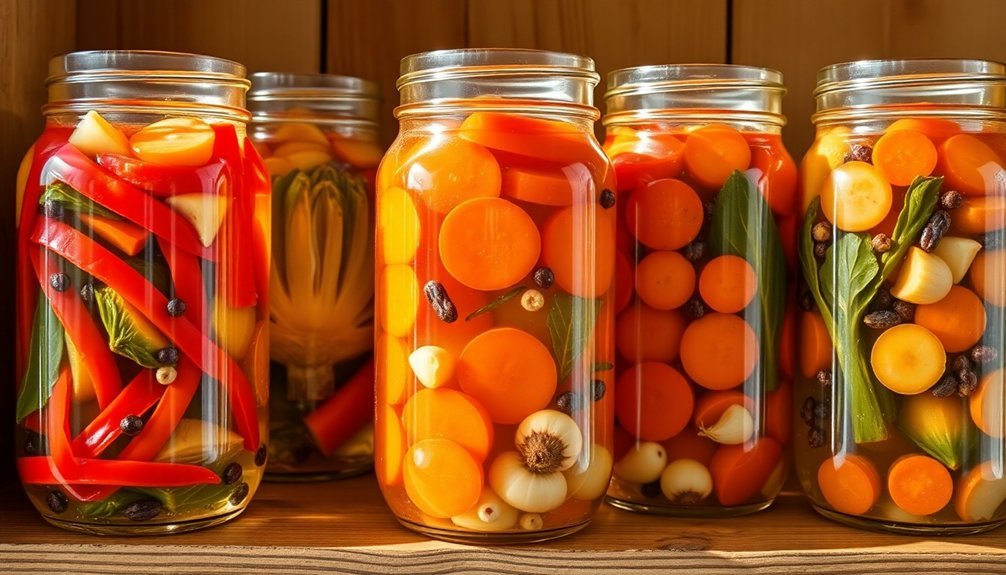
Successful Mediterranean pickling depends on proper storage conditions and careful attention to the fermentation process.
You'll need to store your pickled vegetables in clean, sanitized mason jars, guaranteeing they're completely submerged in brine and kept in an airtight container. For best results, maintain a temperature between 60° to 80°F during fermentation, and keep your jars in a cool, dark place.
When you're working with vinegar-based quick pickles, you can expect them to last 2-4 weeks in the refrigerator. However, if you're using traditional fermentation methods, your pickles can last several months to a year when stored properly.
You'll need to monitor your containers regularly for any signs of spoilage, such as mold growth or unusual odors.
To guarantee successful fermentation, you'll want to use non-iodized or pickling salt to prevent clouding and maintain vegetable color.
Cut your vegetables uniformly to achieve consistent pickling results. Remember to replace the brine periodically to maintain quality, and keep the fermentation temperature below 72°F.
If you're pre-salting or blanching vegetables, do so carefully to prevent excess water release that could dilute your brine.
Building Flavors Over Time
Building Mediterranean flavors in your pickled vegetables requires a thoughtful balance of four key elements: vinegar, spices, herbs, and time.
You'll want to start with a combination of white and white wine vinegar, creating a bright, clean base that won't overpower the delicate Mediterranean herbs. Add whole coriander seeds, mustard seeds, and juniper berries to provide a complex flavor foundation that develops as your pickles mature.
Fresh herbs like dill, oregano, and basil bring authentic Mediterranean character to your pickles. You can enhance these flavors by adding strips of citrus zest and whole garlic cloves to your brine.
As your vegetables pickle, you'll notice the flavors becoming more pronounced and harmonious over several days.
- Imagine the satisfaction of opening your jar after five days to find perfectly crisp vegetables infused with aromatic herbs.
- Picture serving these vibrant pickled vegetables alongside grilled meats at your next gathering.
- Feel the pride of creating an authentic Mediterranean preserved dish using time-honored techniques.
Remember to shake your jars daily to distribute the flavors evenly, and taste-test your pickles periodically to track their development. You can adjust the seasoning by adding more herbs or spices if needed.
Frequently Asked Questions
Can Pickled Vegetables Be Frozen for Longer Storage?
You shouldn't freeze pickled vegetables, as it'll ruin their texture and make them mushy. Instead, keep them in the refrigerator at below 40°F, where they'll stay fresh for 2-3 months.
Why Do Some Pickles Float to the Top of the Jar?
Your pickles float because they're less dense than the brine, mainly due to trapped air pockets in the vegetables. Fresh cucumbers naturally contain hidden air spaces, and bubbles can form between pieces during packing.
Is It Safe to Reuse the Leftover Pickling Liquid?
You can safely reuse pickling brine 1-2 times if it's clear and properly refrigerated. Add fresh vinegar to maintain acidity, and always boil cloudy brine before reuse. Don't exceed two uses for best results.
What Causes Pickled Vegetables to Become Too Soft or Mushy?
Your pickles can become mushy if you don't remove blossom ends, use the wrong cucumber type, expose them to high temperatures, or have weak vinegar. Improper salt ratios and long fermentation also cause softness.
Can I Add More Vegetables to a Jar After Pickling Has Started?
You shouldn't add more vegetables after pickling has started. It'll disrupt the brine balance, create uneven pickling, and may lead to spoilage. Instead, start a fresh jar for your new vegetables.
In Summary
You'll find Mediterranean pickling is both an art and a practical preservation method. Whether you're making marinated artichokes, pickled olives, or spicy peppers, the key is using quality ingredients and proper techniques. Once you've mastered these basics, you can create vibrant, flavorful pickled vegetables that'll last for months. Remember to check your seals regularly and store your jars in a cool, dark place for the best results.

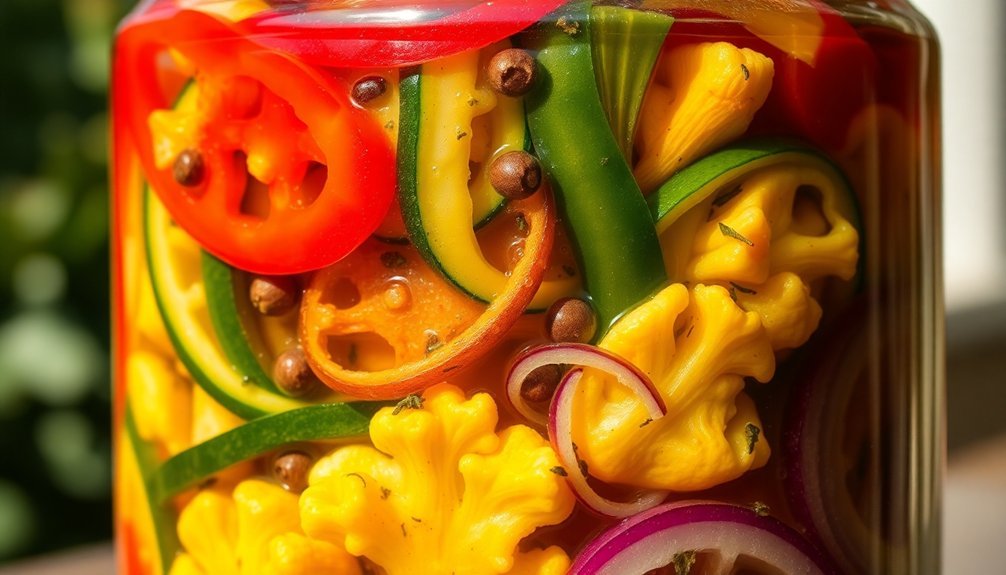



Leave a Reply